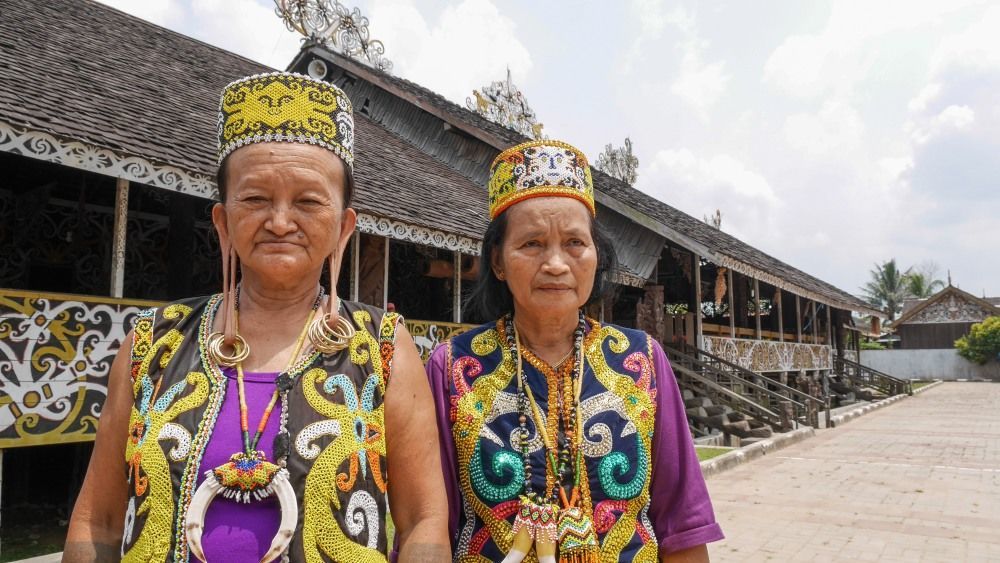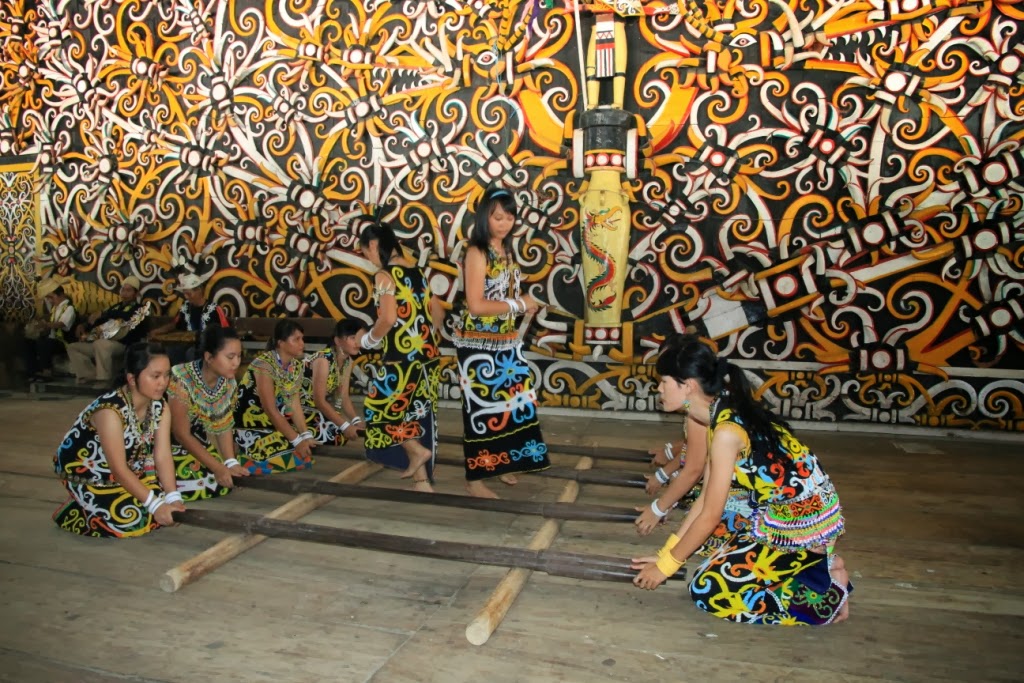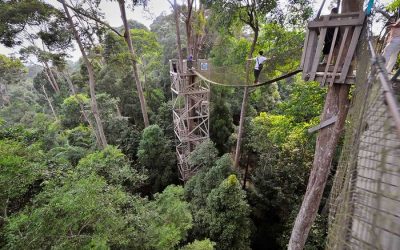Home / Batik Regions – Central Indonesia – Kalimantan Island – East Kalimantan / Pampang Cultural Village
Cultural Destination
Embrace the spirit of the place!
Pampang Cultural Village
The Dayak traditional clothes (photo: Misteraladin)
Lanatip Dance as one of Indonesian national intangible cultural heritage (photo: Widyawati)
Pampang Cultural Village
This area is inhabited by Dayak Kenyah and once a year they hold the village anniversary festival in which people can enjoy lots of Dayak art performances. You can also rent Dayak traditional clothes and take pictures with local people.
Tourist Attractions in East Kalimantan
Bangkirai Hill Natural Conservation Site
If you have always dreamt to do a little adrenaline outdoor activities,
Batik villages in East Kalimantan
Home / Batik Regions - Central Indonesia - Kalimantan Island - East Kalimantan / Batik Village in East Kalimantan Batik Village in East Kalimantansupport the local workshop Brief Story: This unique batik from East Kalimantan are made with various materials. Some...
East Kalimantan
Batik Motifs
Kuntul Perak
Kuntul Perak refers to Egret Silver Bird. This bird is a Kalimantan endemic animal that becomes the
Tengkawang Ampiek
With its many advantages, the Dayaks use this leaf in ritual ceremonies. This plant is a symbol of
Hiu Taliyasan
Indonesia is also home to the world’s largest fish, the whale shark (Rhincodon typus). Hiu Taliyasan refers to
Discover
Indonesian
Batik
Motifs
Besurek Rafflesia
The term “Basurek” refers to a textile that contains letters or inscriptions
Rangkiang
The word “Rangkiang” refers to the rice granary in the Minangkabau language. It symbolizes
Bultiya
The word ‘Bultiya’ is an acronym of the three major tribes in North Kalimantan, namely
Paqbarre Allo
The word “Barre” means round and “Allo” means the sunlight. This motif is interpreted as
Tifa Totobuang
The batik motifs illustrate Maluku’s traditional music instrument called
Ukir Sentani
The Ukir motif is a batik motif that is inspired by various traditional Sentani wood carvings
Jupri Kembang Teh
Kembang Teh illustrates the tendrils of tea plants that grow in the highlands of
Pucuk Rebung Riau
Pucuk Rebung symbolizes heart determination in achieving goals, good luck, and
Gentala Arasy
Built as high as 80 meters, the tower also highlights the historical side of
Gedhog Kembang Waluh
a combination of Javanese cultural motif of the Majapahit kingdom (XII-XIV century) with
Cengkeh
The clove flower motif is the main commodity of the Tolitoli Regency. This motif represents
Manguni Minahasa
Manguni is identified as the symbol of the Minahasa people. Manguni is known as a
Parang Rusak
Another meaning behind this motif is an unconquerable spirit, symbolized by
Tenun Bima
The motifs are adopted from Bima woven textile. This pattern has received a great
Awan Berarak
Awan Berarak is a combination of Dayak motifs and Malay patterns. The word ‘Awan Berarak’ means the
Pinawetengan
The Pinawetengan Batik pattern was taken from a prehistoric inscription in
Gonggong Beruntun
This motif illustrates that a person should maintain a positive attitude and
Keluak Daun Pakis
The word “Keluak” is a Minang language which means twisted or tangled. The Motif of
Pattimura
Pattimura is the name of an Indonesian hero who fought against colonialism in
Gorga Simeol-Meol
The Gorga Simeol-meol is a pattern of plant tendrils. it is regarded as a symbol of longevity and
Ake Patra
Ake is related to the divinity and the composition of the universe. It is a symbol of
Sido Mulyo
Sidomulyo is one of the classical motifs, which is specifically used for the bride’s costume in
Wirasat
Wirasat or divine inspiration is a gift from God. This inspiration is symbolized by
Lok Baintan Floating Market
As you can imagine, the most authentic thing is that you can buy things and even
Burung Bidadari
Bidadari birds are endemic birds in Halmahera. This motif represents an
Buketan Bali
The Balinese bouquet (Buketan Bali) is a floral arrangement and the name is
Desa Na Tolu
The Desa Na Tolu characteristic pattern symbolizes the Batak philosophy of existence and
Pohon Hayat (Tree of Life)
The Batik motifs in Lampung are dominated by the acculturation of Buddhist and
Insang Ikan
Insang refers to the gills of the fish. This is a typical pattern of Malay ethnic who inhabits
Daun Lada Hitam
The black pepper motif represents the main commodity of Bangka Belitung
Enggang Dayak
Local people beliefs that hornbills are an incarnation of the Commander of the Birds. It has supernatural
Tubo Kelapa
Coconut tree is a symbol of a good character and strong mentality. It illustrates the more success a person, the more
Singayaksa
The Singayaksa motif comes from the name of a place where Sultan Hasanuddin used to
Srimanganti
The name of the Srimanganti motif is derived from Palace’s hallway that connects to
Lontara
The Lontara script itself is a typical ancient script of Bugis and Makassar communities. History records that
Bekantan Pakis
This motif represents Pakis Haji (Polystichum setiferum), an endemic plant in
Malinau Cultural Festival
You will witness a unique competition that might not be found other than in
Gigi Haruan Lidi
The Gigi Haruan Lidi motif is taken from the name of the cork fish and is a symbol of
Dayak Kamang
Kamang motif is generally found in the Dayak tribe shield because it is believed to
Daun Simpor
This motif is inspired by the Simpor plant (Dillenia Suffruticosa) which is a typical
Jumputan Bintang
The word Jumputan means the tie-dye technique, while the word “Bintang” refers to
Wakatobi
It symbolizes the coastal beauty of the Wakatobi island and the symbol of Patra symbolizes
Kerawang Tegak Aceh
The Vertical Upright (Kerawang Tegak) Motif symbolizes a person who has a strong
Dayak Taghol
Dayak Taghol has a distinctive style of four curved lines and small dots. This motif represents
Durian Pecah
Broken Durian motifs depict the foundation of faith. The second half signifies the mastery of
Tabir Tanjung
Tanjung flower is a type of Cherry tree flower, which is commonly found in
Gumin Tambun
Based on Hindu mythology, this motif symbolizes lucks, abundant wealth, and
Taiganja
Taiganja is a precious gold pendant that shows the social status of the Kaili family. It is
Tanah Liek
The word “Tanah Liek” refers to clay in Minang language. It is also known as
Besurek Rembulan
This batik illustrates praise for God who created the wonderful universe
Sandeq
Sandeq Boat is a symbol of the maritime importance of the West Sulawesi region. The greatness of
Pati-Pati Pinehiku
It symbolizes the hierarchy in society and the social status of the Mekongga
Kawung
The Kawung motif was created by Sultan Agung Hanyokrokusumo (1593 – 1645) as a symbolic gift for
Bale Lumbu
This motif signifies the welfare of the ancient Sasak society. Bale also symbolizes the
Tangerang Herang
Tangerang Herang motif is a symbol of Tangerang city. The Tangerang Herang batik motif consists of
Karawo Mahkuta
Mahkuta refers to Gorontalo’s traditional crown. It represents noble characters of
Prada Papua
The word “Prada” in the Javanese-Indonesian dialect means a batik textile that
Biji Kopi
The coffee seeds motif illustrates the pride of local coffee specialities in
La Galigo
La Galigo is a literary work of the Buginese Epic that has 300 thousand epic lines. It is considered even
Kain Cual
Cual textile tradition has existed since the 17th century. The word “Cual” refers to
Tongkonan
Toraja’s traditional house is called Tongkonan. Tongkonan is a place for
Mahkota Siger
Siger is the crown of a noblewoman in ancient time. It is a symbol of femininity, strength, and
Leuit Sijimat
This motif reflects the daily activities of the Baduy tribe in Banten. The main ornaments of batik motif consist of:
Tampuk Manggis Sasirangan
The motif illustrates the philosophy of the mangosteen fruit, which is
Salakanagara
Salakanagara batik motif illustrates the first kingdom in the Betawi land
Merak Ngeram
The hatching peacock motif has a very deep meaning which refers to the sacrifice and
Bintik Tujuh
The Bintik Tujuh (Seven Dots) motif has 7 white spots and green color gradation as
Rumah Mamuju
the Batik motif illustrates the house of Mamuju King with the stairs, located on the left of the wooden stage house
Bomba Mawar
This motif means sacred love for family, kingdom, and God; It also illustrates
Lipaq Sabe
Lipaq Saqbe contains a simple geometric classical motif with various flower decorations. This textile is
Kuda Kupang
Horses symbolize wealth. It contains noble values of virtuous characters that bring
Teguh Bersatu
This batik motif shows the strength of the people of Kupang. It also represents a sense of
Pala Salawaku
This motif illustrates the unique weapons of the Maluku region, namely



